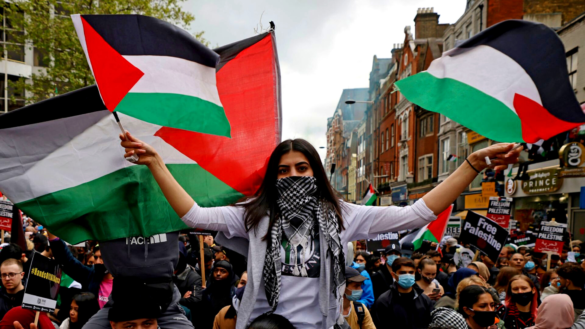We cannot escape the news these days, especially since the conflict in Palestine erupted, pitting Israel against Hamas in a war surpassing any soccer match. As I lounged on my couch, glued to CNN International (my loved ones know well, I’m a CNN addict), I was completely taken aback by an unexpected scene.
Protesters were marching in the streets, holding signs for Palestine, but what really blew my mind was that they were also displaying the Guanacaste flag!
But what on earth were they doing with our beloved flag from our wonderful province of Costa Rica? My eyes were glued to that flag like glue, and I wondered if I was daydreaming. A little voice inside me suggested that there might be a glitch in CNN’s reporting. After all, CNN never makes mistakes, RIGHT?
But since CNN is infallible (or at least they claim to be), I started to entertain a somewhat crazy hypothesis: what if the error was on my side? Me, the viewer, sinking into confusion?
So, I took a quick tour on Google, searched for images of our dear Guanacaste flag, and did the same for the Palestinian flag. And guess what? I almost fell out of my chair: the two flags looked identical to me!
Impossible, I thought. All excited, I returned to my television to realize that these two flags were indeed twins, with one small difference: the color of one of the stripes on the flag in question.
So, for all those who are interested in both Guanacaste, Costa Rica, and the conflict in Palestine, here are my conclusions on the similarities and the small difference between these two flags. I hope this will prevent you from going into a panic or, worse, having a heart attack!
Because you never know when a flag can play tricks on our news-hungry minds!

In fact, both flags (of Guanacaste and Palestine) consist of three horizontal stripes and a red triangle between them, on the left side. The two flags are, so to speak, identical, with the exception of a color difference that makes their distinction slightly challenging.
Indeed, the top stripe of the Palestinian flag is black, while for Guanacaste, it is a rather royal blue tone. Let’s examine together the commonalities and differences between the two flags in question.
The upper stripe:
For Guanacaste, the upper blue stripe represents the clear sky that predominates in the province, mainly in the plains. During the summer, it becomes a sapphire mantle, embodying the fertility of the days and the majesty of the Pacific Ocean beaches along the west coast of Costa Rica.
For Palestine, the upper black stripe is interpreted as a symbol of the past and mourning for Palestinians, in memory of the loss of territory and occupation.
The middle stripe:
For Guanacaste, this stripe symbolizes sincere friendship, hospitality, and the enduring peace in the land of Pura Vida. The middle stripe is white, also symbolizing peace and purity. White also represents hope for a better future for Palestine.
The lower stripe:
The green stripe represents the foliage of the Guanacaste tree, pastures, crops, and the work of all Guanacastecos. The lower stripe is green, traditionally associated with Islam and the fertility of the land. It also symbolizes hope and prosperity for the Palestinian people.
The red triangle:
For Guanacaste, the red triangle exalts the generous heart of the locals, their traditional affection and joy, courage, and spirit of struggle demonstrated time and again. Some argue that the triangle represents the mountain range of the Cordilleras and the volcanoes that populate the province. For Palestine, the meaning of the red triangle aligns with that of Guanacaste, as it represents the mountains of Palestine and the struggle for national liberation.
And did you also know?
The flag of Guanacaste was designed during a competition that was won by Professor Eddie Alvarado Herrera, born in Tilarán on October 15, 1936. The flag was unveiled during a parade on the central avenue of San José in July 1974, on the occasion of the 150th anniversary of the annexation of the Nicoya Party by Costa Rica.
The Palestinian flag is a powerful symbol for Palestinians and is widely used in the context of their quest for self-determination and recognition as a sovereign state. It is important to note that the Palestinian flag may be displayed with various variants and nuances of colors, but the general description mentioned above is the most common.

- Chutes de Cortés : un oasis spectaculaire au cœur du Guanacaste
- At the Table With Silvia: The Executive Chef Who Defines Villa del Sueño
- Silvia Laferrière : la passion culinaire du restaurant de Villa del Sueño
- L’aéroport Juan Santamaría de San Jose se prépare pour une haute saison record
- Le dollar atteint son plus bas niveau en 17 ans au Costa Rica


